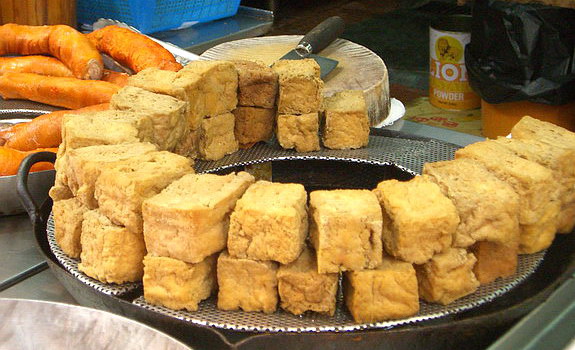chòudòufu cau3 dau6 fu6
臭豆腐

This popular street-food in China must be one of those foods that only Chinese people can enjoy and a only a few foreigners can stomach. I heard the most authentic version of this stinky snack can be found in Taiwan, however I have yet to try it. I've only tried the Hong Kong and Shanghai versions of it. The Shanghai version doesn't taste or smell that much different to plain deep-fried tofu, but the Hong Kong version definitely does have a special taste and smell to it. I wouldn't call it stinky, but my American friends thought otherwise. I guess I'm just that open to trying new and exotic foods.
この人気のある中国の屋台食べ物は、普通は中国人だけが好きで、外国人があまり好きではない食べ物の一つである。最も本格的な臭豆腐は台湾で見つかると聞いたことがあるが、まだ食べたことがない。上海風と香港風の臭豆腐だけを食べたことある。上海風の臭豆腐は普通の揚げ豆腐との味が違いがあまりないが、香港風の臭豆腐は確かに独特な味とにおいがある。自分は臭いと思わないが、友達は臭いと言った。僕は独特な味と臭いに「免疫がある」かもしれない。
Vocabulary:
臭 - smelly, stinky
豆腐 - bean curd
豆 - bean
腐 - rotten
この人気のある中国の屋台食べ物は、普通は中国人だけが好きで、外国人があまり好きではない食べ物の一つである。最も本格的な臭豆腐は台湾で見つかると聞いたことがあるが、まだ食べたことがない。上海風と香港風の臭豆腐だけを食べたことある。上海風の臭豆腐は普通の揚げ豆腐との味が違いがあまりないが、香港風の臭豆腐は確かに独特な味とにおいがある。自分は臭いと思わないが、友達は臭いと言った。僕は独特な味と臭いに「免疫がある」かもしれない。
Vocabulary:
臭 - smelly, stinky
豆腐 - bean curd
豆 - bean
腐 - rotten




No comments:
Post a Comment